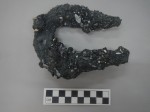 A shipwreck discovered off the coast of Panama in 2011 has been identified as the Nuestra Señora de Encarnación, a ship from one of Spain’s famed silver fleets that sank in a storm in 1681. The Encarnación was a nao, a merchant vessel loaded with cargo from the New World that was one of several ships from the Tierra Firme to sink in the Caribbean Sea just off the north central coast of Panama while travelling from Portobelo, Panama to Cartagena, Colombia.
A shipwreck discovered off the coast of Panama in 2011 has been identified as the Nuestra Señora de Encarnación, a ship from one of Spain’s famed silver fleets that sank in a storm in 1681. The Encarnación was a nao, a merchant vessel loaded with cargo from the New World that was one of several ships from the Tierra Firme to sink in the Caribbean Sea just off the north central coast of Panama while travelling from Portobelo, Panama to Cartagena, Colombia.
 The shipwreck was found by a research team from The Meadows Center for Water and the Environment at Texas State University who were exploring the area in the hopes of finding wrecks of five ships lost by Captain Henry Morgan on his way to sacking Panama City in 1670. When magnetic sensors alerted to the presence of metal objects, researchers dived down and found the wreck of the Encarnación, the lower part of its hull intact and the cargo still in the hold. They presence of so much cargo suggested this was not one of Morgan’s ships since they were heading to Panama City to fill their coffers when they sank.
The shipwreck was found by a research team from The Meadows Center for Water and the Environment at Texas State University who were exploring the area in the hopes of finding wrecks of five ships lost by Captain Henry Morgan on his way to sacking Panama City in 1670. When magnetic sensors alerted to the presence of metal objects, researchers dived down and found the wreck of the Encarnación, the lower part of its hull intact and the cargo still in the hold. They presence of so much cargo suggested this was not one of Morgan’s ships since they were heading to Panama City to fill their coffers when they sank.
 The ship’s cargo includes wooden barrels, more than 100 boxes of sword blades, mule shoes and lead cargo seals that once marked perishable goods. While less glamorous than the gold and silver cargos that made the Spanish fleets famous targets for pirates from the early 16th century through the early 19th, this well-preserved merchant cargo is invaluable to historians. Only 16 Spanish shipwrecks have been found in the New World, and all of them have suffered the depredations of looters, the elements and shipworm. With no architectural designs extant, we know very little about the construction of 17th century Spanish ships. The Encarnación has already filled in some blanks.
The ship’s cargo includes wooden barrels, more than 100 boxes of sword blades, mule shoes and lead cargo seals that once marked perishable goods. While less glamorous than the gold and silver cargos that made the Spanish fleets famous targets for pirates from the early 16th century through the early 19th, this well-preserved merchant cargo is invaluable to historians. Only 16 Spanish shipwrecks have been found in the New World, and all of them have suffered the depredations of looters, the elements and shipworm. With no architectural designs extant, we know very little about the construction of 17th century Spanish ships. The Encarnación has already filled in some blanks.
An initial examination revealed the use of a material called granel, a kind of permanent ballast, says Chris Horrell, a maritime archaeologist working with Hanselmann. It’s “basically a cement consisting of sand, lime, and pebbles,” he explains, that shipbuilders used to coat a ship’s hull with a thin veneer.
Researchers think granel stabilized ships and was also used as a construction material for buildings throughout the New World. Horrell is not yet sure whether granel was a New World invention or an Old World import, but finding out is part of his research agenda.
 The cargo also bears witness to the economic life of Spain and its colonies. The mule shoes indicate the ships brought supplies that would enable their hulls to be stuffed with goods delivered to the Spanish crown. The shoes would have been necessary to equip the mule trains that carried silver, gold and other valuables via overland trade routes from South American territories to the Isthmus of Panama where they would be loaded onto the ships of the fleet and transported to Spain.
The cargo also bears witness to the economic life of Spain and its colonies. The mule shoes indicate the ships brought supplies that would enable their hulls to be stuffed with goods delivered to the Spanish crown. The shoes would have been necessary to equip the mule trains that carried silver, gold and other valuables via overland trade routes from South American territories to the Isthmus of Panama where they would be loaded onto the ships of the fleet and transported to Spain.
 Research on the ship and its contents continue. The artifacts, which by law belong to Panama, are currently being conserved at the laboratory of the Patronato Panamá Viejo, a non-profit organization that manages the historical site and museum of old Panama City.
Research on the ship and its contents continue. The artifacts, which by law belong to Panama, are currently being conserved at the laboratory of the Patronato Panamá Viejo, a non-profit organization that manages the historical site and museum of old Panama City.
Here’s some beautifully clear video of the wreck of the Nuestra Señora de Encarnación: